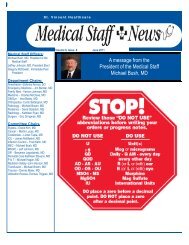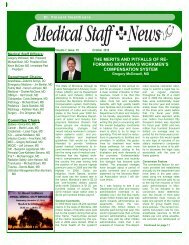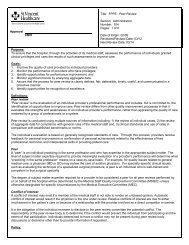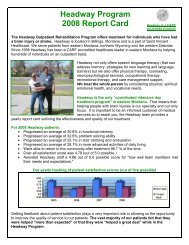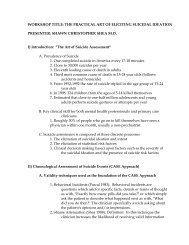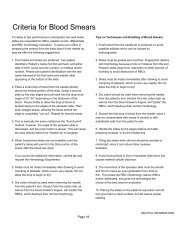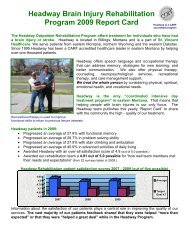AHA/ASA Guideline Guidelines for the Prevention of Stroke in ...
AHA/ASA Guideline Guidelines for the Prevention of Stroke in ...
AHA/ASA Guideline Guidelines for the Prevention of Stroke in ...
Create successful ePaper yourself
Turn your PDF publications into a flip-book with our unique Google optimized e-Paper software.
228 <strong>Stroke</strong> January 2011<strong>Stroke</strong> is a major source <strong>of</strong> mortality and morbidity <strong>in</strong> <strong>the</strong>United States. Survivors <strong>of</strong> a transient ischemic attack (TIA)or stroke represent a population at <strong>in</strong>creased risk <strong>of</strong> subsequentstroke. Approximately one quarter <strong>of</strong> <strong>the</strong> 795 000 strokes thatoccur each year are recurrent events. The true prevalence <strong>of</strong> TIAis difficult to gauge because a large proportion <strong>of</strong> patients whoexperience a TIA fail to report it to a healthcare provider. 1 On<strong>the</strong> basis <strong>of</strong> epidemiological data def<strong>in</strong><strong>in</strong>g <strong>the</strong> determ<strong>in</strong>ants <strong>of</strong>recurrent stroke and <strong>the</strong> results <strong>of</strong> cl<strong>in</strong>ical trials, it is possible toderive evidence-based recommendations to reduce stroke risk.Notably, much <strong>of</strong> <strong>the</strong> exist<strong>in</strong>g data come from studies withlimited numbers <strong>of</strong> older adults, women, and diverse ethnicgroups, and additional research is needed to confirm <strong>the</strong> generalizability<strong>of</strong> <strong>the</strong> published f<strong>in</strong>d<strong>in</strong>gs.The aim <strong>of</strong> this statement is to provide cl<strong>in</strong>icians with <strong>the</strong>most up-to-date evidence-based recommendations <strong>for</strong> <strong>the</strong>prevention <strong>of</strong> ischemic stroke among survivors <strong>of</strong> ischemicstroke or TIA. A writ<strong>in</strong>g committee chair and vice chair weredesignated by <strong>the</strong> <strong>Stroke</strong> Council Manuscript OversightCommittee. A writ<strong>in</strong>g committee roster was developed andapproved by <strong>the</strong> <strong>Stroke</strong> Council with representatives fromneurology, cardiology, radiology, surgery, nurs<strong>in</strong>g, pharmacy,and epidemiology/biostatistics. The writ<strong>in</strong>g groupconducted a comprehensive review and syn<strong>the</strong>sis <strong>of</strong> <strong>the</strong>relevant literature. The committee reviewed all compiledreports from computerized searches and conducted additionalsearches by hand. These searches are available on request.Searches were limited to English-language sources and humansubjects. Literature citations were generally restricted topublished manuscripts appear<strong>in</strong>g <strong>in</strong> journals listed <strong>in</strong> IndexMedicus and reflected literature published as <strong>of</strong> August 1,2009. Because <strong>of</strong> <strong>the</strong> scope and importance <strong>of</strong> certa<strong>in</strong>ongo<strong>in</strong>g cl<strong>in</strong>ical trials and o<strong>the</strong>r emerg<strong>in</strong>g <strong>in</strong><strong>for</strong>mation, publishedabstracts were cited <strong>for</strong> <strong>in</strong><strong>for</strong>mational purposes when<strong>the</strong>y were <strong>the</strong> only published <strong>in</strong><strong>for</strong>mation available, butrecommendations were not based on abstracts alone. Thereferences selected <strong>for</strong> this document are exclusively <strong>for</strong>peer-reviewed papers that are representative but not all<strong>in</strong>clusive,with priority given to references with higher levels<strong>of</strong> evidence. All members <strong>of</strong> <strong>the</strong> committee had frequentopportunities to review drafts <strong>of</strong> <strong>the</strong> document and reach aconsensus with <strong>the</strong> f<strong>in</strong>al recommendations. Recommendationsfollow <strong>the</strong> American Heart Association (<strong>AHA</strong>) and <strong>the</strong>American College <strong>of</strong> Cardiology (ACC) methods <strong>of</strong> classify<strong>in</strong>g<strong>the</strong> level <strong>of</strong> certa<strong>in</strong>ty <strong>of</strong> <strong>the</strong> treatment effect and <strong>the</strong>class <strong>of</strong> evidence (Tables 1 and 2). 2Although prevention <strong>of</strong> ischemic stroke is <strong>the</strong> primaryoutcome <strong>of</strong> <strong>in</strong>terest, many <strong>of</strong> <strong>the</strong> grades <strong>for</strong> <strong>the</strong> recommendationswere chosen to reflect <strong>the</strong> exist<strong>in</strong>g evidence on <strong>the</strong>reduction <strong>of</strong> all vascular outcomes after stroke or TIA, <strong>in</strong>clud<strong>in</strong>gsubsequent stroke, myocardial <strong>in</strong>farction (MI), and vasculardeath. The recommendations <strong>in</strong> this statement are organized tohelp <strong>the</strong> cl<strong>in</strong>ician who has arrived at a potential explanation <strong>of</strong><strong>the</strong> cause <strong>of</strong> ischemic stroke <strong>in</strong> an <strong>in</strong>dividual patient and isembark<strong>in</strong>g on selection <strong>of</strong> a <strong>the</strong>rapy to reduce <strong>the</strong> risk <strong>of</strong> arecurrent event and o<strong>the</strong>r vascular outcomes. Our <strong>in</strong>tention is toupdate <strong>the</strong>se statements every 3 years, with additional <strong>in</strong>tervalupdates as needed, to reflect <strong>the</strong> chang<strong>in</strong>g state <strong>of</strong> knowledge on<strong>the</strong> approaches to prevent a recurrent stroke.Def<strong>in</strong>ition <strong>of</strong> TIA and Ischemic<strong>Stroke</strong> SubtypesA TIA is an important predictor <strong>of</strong> stroke. The 90-day risk <strong>of</strong>stroke after a TIA has been reported as be<strong>in</strong>g as high as 17%,with <strong>the</strong> greatest risk apparent <strong>in</strong> <strong>the</strong> first week. 3,4 Thedist<strong>in</strong>ction between TIA and ischemic stroke has become lessimportant <strong>in</strong> recent years because many <strong>of</strong> <strong>the</strong> preventiveapproaches are applicable to both. 5 TIA and ischemic strokeshare pathophysiologic mechanisms, but prognosis may varydepend<strong>in</strong>g on severity and cause, and def<strong>in</strong>itions are dependenton <strong>the</strong> tim<strong>in</strong>g and extent <strong>of</strong> <strong>the</strong> diagnostic evaluation. Byconventional cl<strong>in</strong>ical def<strong>in</strong>itions, <strong>the</strong> presence <strong>of</strong> focal neurologicalsymptoms or signs last<strong>in</strong>g 24 hours has beendef<strong>in</strong>ed as a TIA. With more widespread use <strong>of</strong> modernimag<strong>in</strong>g techniques <strong>for</strong> <strong>the</strong> bra<strong>in</strong>, up to one third <strong>of</strong> patientswith symptoms last<strong>in</strong>g 24 hours have been found to have an<strong>in</strong>farction. 5,6 This has led to a new tissue-based def<strong>in</strong>ition <strong>of</strong>TIA: a transient episode <strong>of</strong> neurological dysfunction causedby focal bra<strong>in</strong>, sp<strong>in</strong>al cord, or ret<strong>in</strong>al ischemia, without acute<strong>in</strong>farction. 5 Notably, <strong>the</strong> majority <strong>of</strong> studies described <strong>in</strong> thisguidel<strong>in</strong>e used <strong>the</strong> older def<strong>in</strong>ition. Recommendations providedby this guidel<strong>in</strong>e are believed to apply to both strokeand TIA regardless <strong>of</strong> which def<strong>in</strong>ition is used.The classification <strong>of</strong> ischemic stroke is based on <strong>the</strong>presumed mechanism <strong>of</strong> <strong>the</strong> focal bra<strong>in</strong> <strong>in</strong>jury and <strong>the</strong> typeand localization <strong>of</strong> <strong>the</strong> vascular lesion. The classic categorieshave been def<strong>in</strong>ed as large-artery a<strong>the</strong>rosclerotic <strong>in</strong>farction,which may be extracranial or <strong>in</strong>tracranial; embolism from acardiac source; small-vessel disease; o<strong>the</strong>r determ<strong>in</strong>ed causesuch as dissection, hypercoagulable states, or sickle celldisease; and <strong>in</strong>farcts <strong>of</strong> undeterm<strong>in</strong>ed cause. 7 The certa<strong>in</strong>ty <strong>of</strong>classification <strong>of</strong> <strong>the</strong> ischemic stroke mechanism is far fromideal and reflects <strong>the</strong> <strong>in</strong>adequacy <strong>of</strong> <strong>the</strong> diagnostic workup <strong>in</strong>some cases to visualize <strong>the</strong> occluded artery or localize <strong>the</strong>source <strong>of</strong> <strong>the</strong> embolism. The sett<strong>in</strong>g <strong>of</strong> specific recommendations<strong>for</strong> <strong>the</strong> tim<strong>in</strong>g and type <strong>of</strong> diagnostic workup <strong>for</strong>patients with TIA or stroke is beyond <strong>the</strong> scope <strong>of</strong> <strong>the</strong>seguidel<strong>in</strong>es; at a bare m<strong>in</strong>imum, all stroke patients should havebra<strong>in</strong> imag<strong>in</strong>g with computed tomography or magnetic resonanceimag<strong>in</strong>g (MRI) to dist<strong>in</strong>guish between ischemic andhemorrhagic events, and both TIA and ischemic strokepatients should have an evaluation sufficient to excludehigh-risk modifiable conditions such as carotid stenosis oratrial fibrillation (AF) as <strong>the</strong> cause <strong>of</strong> ischemic symptoms.I. Risk Factor Control <strong>for</strong> All Patients WithTIA or Ischemic <strong>Stroke</strong>A. HypertensionAn estimated 72 million Americans have hypertension, def<strong>in</strong>edas a systolic blood pressure (BP) 140 mm Hg ordiastolic BP 90 mm Hg. 8 Overall, <strong>the</strong>re is an associationbetween both systolic and diastolic BP and risk <strong>of</strong> strokewithout a clear threshold even at a systolic BP <strong>of</strong>115 mm Hg. 9 Meta-analyses <strong>of</strong> randomized controlled trialshave shown that BP lower<strong>in</strong>g is associated with a 30% to 40%reduction <strong>in</strong> risk <strong>of</strong> stroke. 10–12 Risk reduction is greater withlarger reductions <strong>in</strong> BP without clear evidence <strong>of</strong> a drugclass–specific treatment effect. 12 Evidence-based recommen-Downloaded from stroke.ahajournals.org by on March 8, 2011



